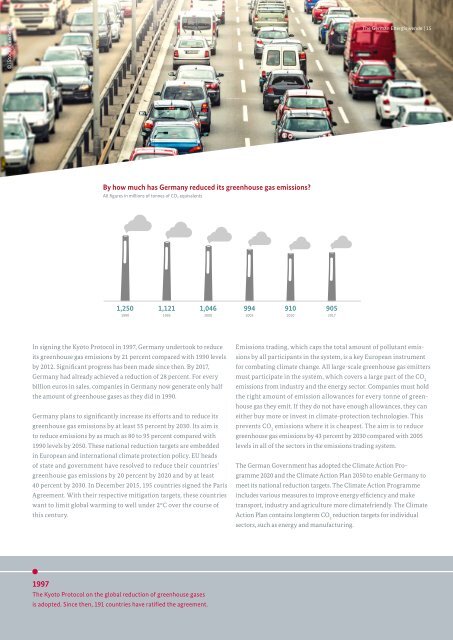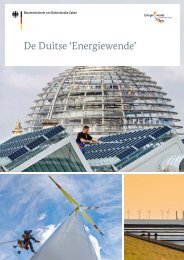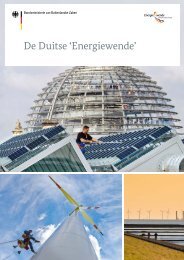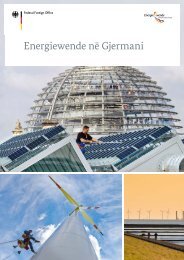The German Energiewende
Create successful ePaper yourself
Turn your PDF publications into a flip-book with our unique Google optimized e-Paper software.
© iStock/ querbeet<br />
<strong>The</strong> <strong>German</strong> <strong>Energiewende</strong> | 15<br />
By how much has <strong>German</strong>y reduced its greenhouse gas emissions?<br />
All figures in millions of tonnes of CO2 equivalents<br />
1,250<br />
1990<br />
1,121<br />
1995<br />
1,046<br />
2000<br />
994<br />
2005<br />
910<br />
2010<br />
905<br />
2017<br />
In signing the Kyoto Protocol in 1997, <strong>German</strong>y undertook to reduce<br />
its greenhouse gas emissions by 21 percent compared with 1990 levels<br />
by 2012. Significant progress has been made since then. By 2017,<br />
<strong>German</strong>y had already achieved a reduction of 28 percent. For every<br />
billion euros in sales, companies in <strong>German</strong>y now generate only half<br />
the amount of greenhouse gases as they did in 1990.<br />
<strong>German</strong>y plans to significantly increase its efforts and to reduce its<br />
greenhouse gas emissions by at least 55 percent by 2030. Its aim is<br />
to reduce emissions by as much as 80 to 95 percent compared with<br />
1990 levels by 2050. <strong>The</strong>se national reduction targets are embedded<br />
in European and international climate protection policy. EU heads<br />
of state and government have resolved to reduce their countries’<br />
greenhouse gas emissions by 20 percent by 2020 and by at least<br />
40 percent by 2030. In December 2015, 195 countries signed the Paris<br />
Agreement. With their respective mitigation targets, these countries<br />
want to limit global warming to well under 2°C over the course of<br />
this century.<br />
Emissions trading, which caps the total amount of pollutant emissions<br />
by all participants in the system, is a key European instrument<br />
for combating climate change. All large-scale greenhouse gas emitters<br />
must participate in the system, which covers a large part of the CO 2<br />
emissions from industry and the energy sector. Companies must hold<br />
the right amount of emission allowances for every tonne of greenhouse<br />
gas they emit. If they do not have enough allowances, they can<br />
either buy more or invest in climate-protection technologies. This<br />
prevents CO 2<br />
emissions where it is cheapest. <strong>The</strong> aim is to reduce<br />
greenhouse gas emissions by 43 percent by 2030 compared with 2005<br />
levels in all of the sectors in the emissions trading system.<br />
<strong>The</strong> <strong>German</strong> Government has adopted the Climate Action Programme<br />
2020 and the Climate Action Plan 2050 to enable <strong>German</strong>y to<br />
meet its national reduction targets. <strong>The</strong> Climate Action Programme<br />
includes various measures to improve energy efficiency and make<br />
transport, industry and agriculture more climatefriendly. <strong>The</strong> Climate<br />
Action Plan contains longterm CO 2<br />
reduction targets for individual<br />
sectors, such as energy and manufacturing.<br />
1997<br />
<strong>The</strong> Kyoto Protocol on the global reduction of greenhouse gases<br />
is adopted. Since then, 191 countries have ratified the agreement.

















